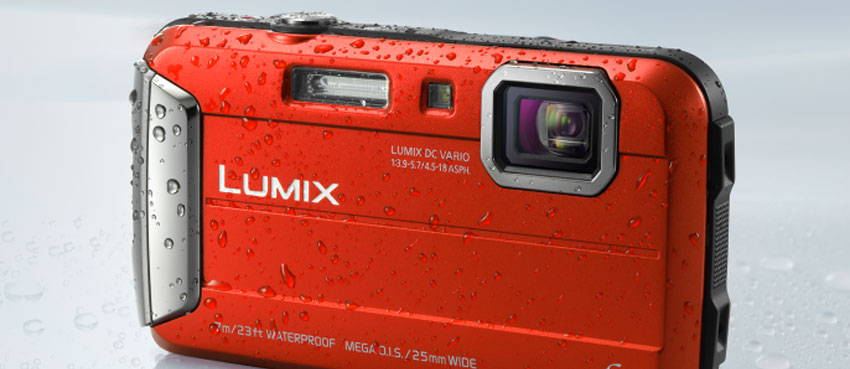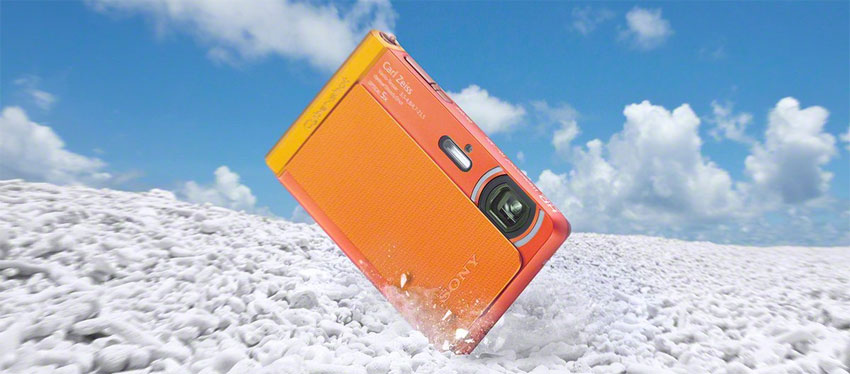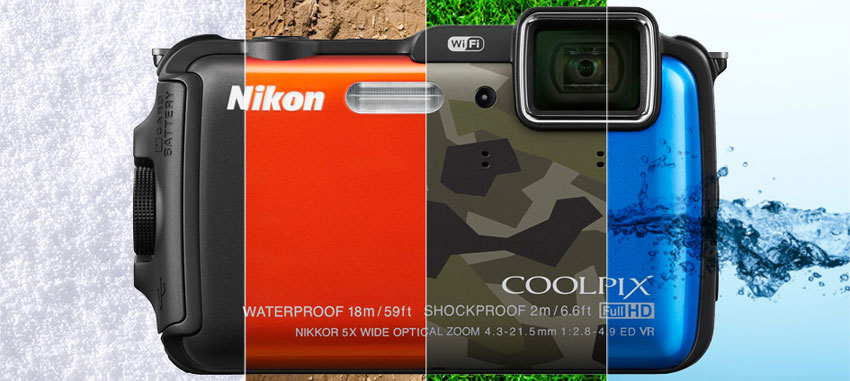5 vacation cameras
We independently test the products and technologies that we recommend.
You can find out the technical characteristics of the models presented in the article in the comparative table. Cameras of all kinds with detailed descriptions are available in the corresponding directory.
|
|
Relatively low price, high performance, powerful LED for illumination during video shooting.
Not the best display, low battery life.
|
The most affordable participant in our review is the youngest model in the Panasonic series of protected cameras. According to the manufacturer, this camera is not afraid of immersion in water to a depth of up to 7 metres, falling from a height of up to 1.5 m and working in the cold up to -10 degrees. The camera has a plastic, not a metal case, but it is still stronger than conventional models. During one DMC-FT25 test, the camera was thrown from a metre and a half high onto a concrete floor with the screen down. The model normally suffered a fall and continued to work. The camera object is securely covered with tempered glass, which is not afraid of scratches, although it can collect fingerprints. The battery compartment, in turn, is protected from water, sand and dust by a door with a two-stage lock. And as for frost resistance, remember — negative temperature negatively affects the battery charge and reduces the battery life of the camera. Under normal conditions, the camera's lithium-ion battery allows you to take up to 250 pictures on a single charge (according to the CIPA measurement standard). The camera's 2.7-inch diagonal display has a very small resolution of 230K pixels and is not distinguished by the largest viewing angles. The latter is compensated by a special mode of operation: increasing the brightness of the backlight and reducing the contrast make the display "readable" when viewed from an angle. On a sunny day outside, the screen fades, so it is advisable to view the pictures in the shade. Also, the reviews note the not always confident operation of the exposamer. Panasonic is characterized by high performance: the flash recharges quickly, the pauses between frames are small. The camera shows itself well in serial photography: with full resolution, it shoots at a speed of 1.3 frames / sec. If, of course, you equip the DMC-FT25 with a fast SD card. The photo quality corresponds to low-cost cameras, favorably standing out with excellent sharpness. The DMC-FT25 is the only camera in our review that cannot shoot video in Full HD. In the video mode, it is limited to HD 720p resolution. But it has a powerful LED located next to the flash, which is used to highlight autofocus and as an illuminator when shooting video underwater. |
|
|
Stylish and thin metal body, good photo quality, high speed, large touch screen, convenient panoramic shooting function.
The touch screen does not work under water and fades in the sun, not the best detail of the pictures, short battery life.
|
Sony DSC-TX30 by its appearance refutes the stereotype that a protected camera should be bulky. The model is enclosed in a stylish metal case, which is noticeably thinner (15.4 mm) and lighter (125 g) than the rest of the review participants. Note that the Olympus TG-3 camera is twice as thick and heavier. Despite the elegance of the design, the DSC-TX30 is rightfully called protected. According to Sony, the camera can stay underwater for up to 60 minutes at a depth of up to 10 m and withstand a fall from a height of 1.5 m. Of course, the body of the model is also protected from dust. The DSC-TX30 has a sliding object cover made of brushed metal and a touchscreen display that occupies almost the entire back panel. The most compact model in our TOP 5 has the largest screen: its diagonal is 3.3" with an impressive resolution of 1229K pixels. Moreover, the DSC-TX30 display pleases with excellent image quality, with rich colours and large viewing angles. But there is one "but": the display becomes almost useless under water – it will not work to change the photo settings during the filming of coral reefs. Moreover, sometimes even on land, if water gets on the display, it will stop working properly. And the camera has no physical buttons at all – this is a payment for a large diagonal of the screen in a compact case. So, if you are planning to do underwater filming or take a lot of photos by the water – pay attention to the other cameras in our review. As for actually taking photos, Sony offers a lot of possibilities: good automatic mode, expansion of the dynamic range of photos, panoramic shooting, etc. The DSC-TX30 tests note the high speed of the camera: high speed of switching on, focus, saving pictures. The captured frames are distinguished by good colour reproduction and accurate exposure. However, the "megapixel race", in which Sony participates, played a role. The DSC-TX30 matrix has the same size as the rest of the cameras in our review, as much as 18 MP, and this led to an increase in the "noise" of the photos. The battery life of the DSC-TX30 is similar to that of the Panasonic model: 250 shots on a single charge according to the CIPA standard. For this class of cameras, this indicator is below average. |
|
|
Wide-angle object, fast focus, GPS system with compass and world map, good value for money.
The display fades in the sun, blurred parts when shooting in low light conditions.
|
At the price, the Nikon AW120 is in the middle of our rating, but at the same time it has rich functionality. This allows us to call this model the best in the review in terms of price and quality ratio. According to the manufacturer, the AW120 can work underwater at a depth of up to 18 m, can withstand falls from a two-metre height and is able to take pictures in the cold up to -10 °C. There is only one door on the camera body, it is protected by a seal and a reliable rotary latch. Behind the door there is a compartment for the battery and memory card, as well as micro-USB and HDMI ports. The camera battery allows you to take 350 pictures according to the CIPA standard (with Wi-Fi and GPS disabled). The AW120, like the two more expensive cameras in our review, is equipped with a GPS module. The model records the geographical coordinates of the images, and also allows you to view a world map, use a compass and find out about the nearest "points of interest", such as cafes and restaurants. GPS does not work underwater, but the camera records the depth at which the photos were taken. Another plus of the camera is the availability of Wi—Fi, which makes it possible to transfer the footage to a computer wirelessly. The 3-inch camera display with a resolution of 921K pixels indoors or in the shade looks great. And on the street on a sunny day, it does not show itself from the best side — the image fades a little. The model has a wide-angle object of 24-120 mm with a 5x optical zoom and a good aperture of f/2.8–f/4.9. Camera test on the website dpreview.com He showed that in normal lighting, such an object in combination with a 16 MP matrix provides quite decent photo quality. In such conditions, the AW120 also shows excellent switching and focus speed. However, in low—light conditions, the AW120, like most compact cameras, begins to have problems — the details in the pictures are blurred. The AW120's underwater shooting capabilities (both in fresh water and in the sea) are highly appreciated by divers. At shallow depths and with a sufficient level of illumination, it is quite possible to shoot with this camera even without a flash — a large photosensitivity helps (up to ISO 6400). When shooting underwater, the camera can be controlled by tilting the body. This is more convenient than pressing buttons, especially in a wetsuit. |
|
|
Good quality underwater photography, high sharpness of images, high-quality display, record diving depth.
The video recording quality could be better, there is no Wi-Fi.
|
The main feature of the Canon PowerShot D30 is record depth of immersion under water: 25 metres. The closest competitor Nikon AW120 lagged by as much as 7 metres. In fact, this is unlikely to be useful even when diving, but it indicates a high level of hull protection. The model can not just dive, but also take quite high-quality photos under water. Experts note that the underwater images of the D30 do not go into the blue, which is often observed in amateur cameras. The rest of the claimed parameters of the "survivability" of the camera are standard — it must withstand frost up to -10 °C and a fall from two metres. The camera doesn't have Wi-Fi, but it does have GPS. However, the functionality of the latter is limited only to recording coordinates. The capabilities of the D30 battery are estimated at 300 images according to the CIPA standard (with GPS disabled), which should be enough for a day of travel. The resolution of the D30 matrix is the smallest among the compared models (12 MP), but this is not critical for the quality of amateur photos. In tests, the D30 object shows good sharpness and does not blur the details around the edges of the images too much (the latter is characteristic of cameras of this class). The camera can shoot video with Full HD resolution, but with a frequency of only 24 frames per second. For the rest of the review participants, this figure is 30, and for Sony DSC-TX30 — even 60 frames / s. The quality of the video recording, according to reviews, is average. Experts also highly appreciated the camera display. Despite the small resolution of 460K pixels, the screen has a number of advantages: wide viewing angles, excellent colour reproduction and contrast. In addition, the D30 display is equipped with a very durable protective coating that will protect it in the most extreme situations. |
|
|
High-power object, serial shooting of 5 frames/s, long battery life, functional GPS system.
High price, video recording quality could be better.
|
Olympus has extensive experience in the production of protected cameras and the TG-3 is one of them. According to the manufacturer, the TG-3 is not afraid of diving to a depth of 15 m, falling from a height of 2 metres and ten-degree frost. Moreover, the chamber can withstand pressure up to 100 kg. At the highest price in our review, Olympus TG-3 has a number of serious advantages. First of all, this concerns the object, which has the largest range of aperture values among the described models — f/2.0–f/4.9. With a maximum aperture of f/2.0, more light falls on the matrix, which reduces the amount of noise in the photo and allows you to take high-quality pictures underwater. In the camera review on the website dpreview.com the photo quality of the TG-3 was rated as above average for compact cameras, with good sharpness and without significant blurring at the edges of the frame. Underwater pictures also look decent, without going into the blue (at the same time, the blue colour still prevails in the video under water). The speed of the TG-3 is at altitude: the camera turns on in less than a second, autofocus is very fast in good light and not bad in low light. Olympus can take a series of up to 100 photos at a speed of 5 frames per second — an impressive figure for a compact camera. Special attention should be paid to the "super macro" mode, which makes it possible to shoot from a distance of only 1 cm. And fans of manually controlling the shooting parameters will like the aperture priority mode. The camera is equipped with Wi-Fi and GPS modules with a compass and a pressure gauge (to monitor the pressure at depth). Finally, the Olympus TG-3 demonstrates the best battery endurance among the cameras of our review: 380 images on a single charge according to the CIPA standard. |
Five good cards with a capacity of 32 GB for video cameras, SLR and mirrorless cameras.
Five cameras that can surprise both with their capabilities and compact size.
We choose a replacement for low-cost "mirrors" and "mirrorless mirrors" in the form of a small-sized camera with a high-power object.
Five excellent tripods that are popular among buyers of online stores.
We have selected five smartphones with advanced optics that can replace the usual camera.
Articles, reviews, useful tips
All materials





















